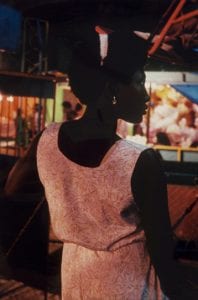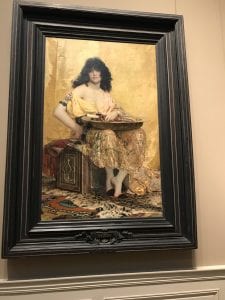When I was in Brazil, I came across this photo while visiting the MAR, Rio’s museum of art. It is titled “Rosa no arraial,” and it was taken by Luiz Braga. The woman has her back to the camera, her eyes gazing off into the distance and her body leaning in anticipation. Her facial expression communicates that she is fixated upon something. Her hair is in a small afro, accessorized with a patterned headband that matches her pale pink dress, and tiny earrings dangle from her lobes. In the background of the photo is an “arraial” or campground. The setting is blurred to fixate attention on the woman, but it seems like there is a carnival of some sort going on as there are bright colors and outlines of structures that seem like they could be rides.
This photo captivated my attention because of the way the woman pictured is being looked upon by whoever views this photo. While she is focused on something, we are focused on her, and she is what is attracting, luring, and drawing us into the work. The contrast of her skin tone with the dress and the brightness of the background work together, making her this enticing but mysterious figure because her gaze is positioned outside of the frame.
During our trip to New York, this portrait drew my attention because of its carefree nature. Henri Regnault painted Salomé first intending for her to be an African woman but changed the painting to a representation of a Biblical temptress, Salomé. The woman’s demeanor has an air of silliness. She sits upon a box that I assume to be filled with riches with her elbow poked out as if she were cocking her hip. Her other hand is wrapped around something in the tray on her lap. Her clothing is flowy and light, matching her energy. Her lips seem to be slightly smirking as if she is a few seconds away from breaking out in laughter, and her hair falls in loose, messy ringlets around her face. Another factor that drew me to this painting was the representation aspect of it. Because I read that this was originally supposed to be an Italian model depicted as an African woman, I was a bit upset. There is an overall lack of representation of black people within artwork, and because this painting was created in the 1800s, I’m not surprised at the original intent of the artist, but it shows the way in which black people were strategically excluded from this world.



I think it is really interesting when you discuss the multiple sight lines that are taking place in “Rosa no arraial” and how although she is disengaged with the viewer and completely fixated on something or someone beyond the composition, the viewer is fixated on her. The more she looks away and the more determined she is about it, the more fascinated we are and the harder it is to look away.